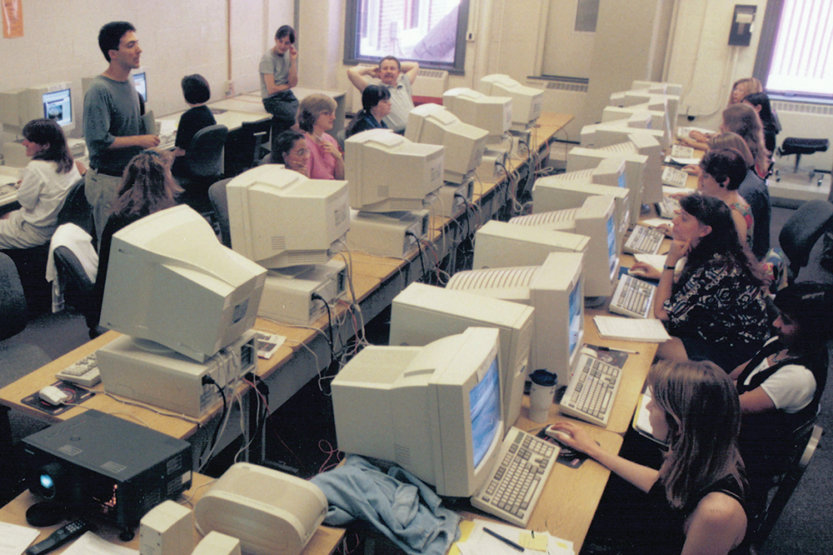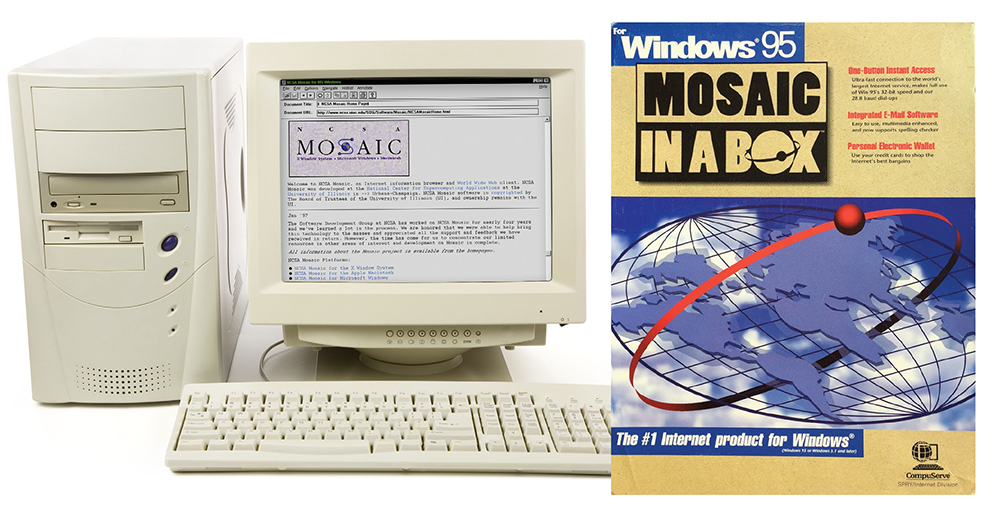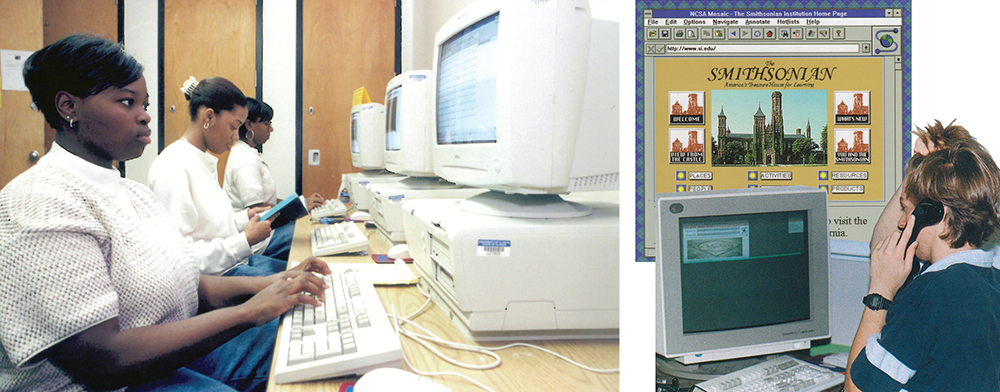Memory Lane: Surfing the Interwebs
 Computer labs and new-fangled web browsers were staples of the ’90s scene. Library science graduate students use the internet in class in 1998. (Image courtesy of UIAA)
Computer labs and new-fangled web browsers were staples of the ’90s scene. Library science graduate students use the internet in class in 1998. (Image courtesy of UIAA) It was a beautiful spring day in 1993, finals only weeks away, and as she had many times that semester, Page Wolf, ’93 MEDIA, walked into Gregory Hall, entered the classroom and found her seat. The course was Photojournalism, and on that day, her professor, Brian Johnson, MS ’89 MEDIA, had something special in store for his students—something they had never seen before.
“It was Time magazine,” Wolf says. “But instead of a paper copy, it was on a computer, and we could click on links and see articles!”
It was the students’ first time using the Mosaic web browser, which had recently been developed by the U of I’s National Center for Supercomputing Applications. Within a year, Mosaic would be the browser of choice for 95 percent of all internet users and would help to kick off the Internet Age. But on that April day, it was brand-new, and “it blew our minds,” Wolf recalls.
Wolf and her classmates were in the right place at the right time: on a campus that boasted a spirit of innovation, one of the world’s fastest computer networks and professors who were open to new technologies.
Today, the internet is such a ubiquitous force in our lives that we often take it for granted. But in the early-to-mid-’90s, it seemed novel and science fictional and full of possibility.
Illinois alumni from those years remember using the internet in a variety of ways that now seem commonplace; but at the time were anything but.

The once-ubiquitous Mosaic software box, now a relic of a former age. (Image courtesy of Jimena Canales)
Although they’ve visited thousands of websites over the past three decades, most alumni can still remember the first one they saw. For Heather Murphy, ’96 MEDIA, it was for The Late Show with David Letterman, on a computer at the Undergraduate Library. She recalls thinking “how exciting it was to access information in such a fun, new way.”
Many others remember getting their first “electronic mail” address. For Bill Bell, ’98 MEDIA, MSLIS ’03, it was the University-issued account he got during summer registration in 1994. “I had no way to use it until I came to school in the fall,” he says. But after that, “email was instantly a part of my day-to-day.”
Like most students in those days, Bell didn’t own a computer, and he spent a lot of time in University computer labs among his peers.
“People were always there,” he says, “working on papers, emailing, reading Usenet groups and surfing early websites,” like the Internet Movie Database. “The lab was a place to find people—as collegiate as a space gets, only wired to the whole world.”
Aside from email and trawling the computer labs, one of the most popular ways that students connected with friends (or strangers) at that time was through chat services, such as Pine and Internet Relay Chat (IRC).
Occasionally, a chance encounter with a stranger in a chat room would lead to a real-life friendship or romance, as it did for Earl Bonovich, ’96 ENG, and Anne Estandarte Bonovich, ’96 LAS. They met on IRC during their freshman year and recently celebrated their 25th wedding anniversary. “IRC was the Match.com/eharmony/Tinder of the day!” Anne says.
When students weren’t chatting, many spent their free time playing online games, such as Doom and Diablo. Sean Mackenzie, ’91 LAS, often dialed into the U of I system from his apartment and “clogged up the phone lines” to play Avatar, a Dungeons & Dragons-style game.

Whether students used the high-speed connections on campus or dial-up in their off-campus abodes, surfing the web could be a hair-pulling experience. (Left) Undergrads use those high-speed connections, in one of the University’s many basement computer labs, 1996. (Middle) The Smithsonian Institution’s homepage, as it appeared in Mosaic, 1994. (Right) A student works on a course project from the comfort of home, 1995. (Images courtesy of Illini Media and National Center for Supercomputing Applications)
Other students didn’t have to worry about that. “At Sigma Tau Gamma, we used a local network to connect our computers and Nintendos,” says Ron Warfel, ’99 LAS. “We played lots of Star Wars and Mario Kart!”
In addition to games, students used the campus’ “fast” internet connection to watch online videos, despite bit rates that would now drive the average person insane. Chris Murin, ’97 FAA, remembers his jaw dropping when he saw the original South Park short on a website, years before it became a television show.
Other alumni recall the excitement they felt the first time they bought something online. For Mindy Spencer, ’97 ACES, MBA ’98, it was a book on the brand-new Amazon.com, forever changing the way she shopped.
Whether alumni used the internet for fun, games, education, art or commerce, it provided them with a new way of seeing the world around them.
For some, those early experiences with the internet even led to future careers.
“I built my own fan website for the TV sitcom Wings,” says Kevin Koperski, ’99 LAS, and “I was invited by the show’s creators to visit the set in Hollywood.” Today, Koperski is a successful Internet entrepreneur. That Wings website “jumpstarted my entire career,” he says.
As for Page Wolf? Her experience reading Time magazine on her computer inspired her “to learn more.” She applied to graduate school in instructional technology and later became a pioneer in online course development—all because of “an amazing professor” who introduced his students to a new invention.
The internet “changed my world,” Wolf says.
Thirty years later, the rest of us can say the same.

